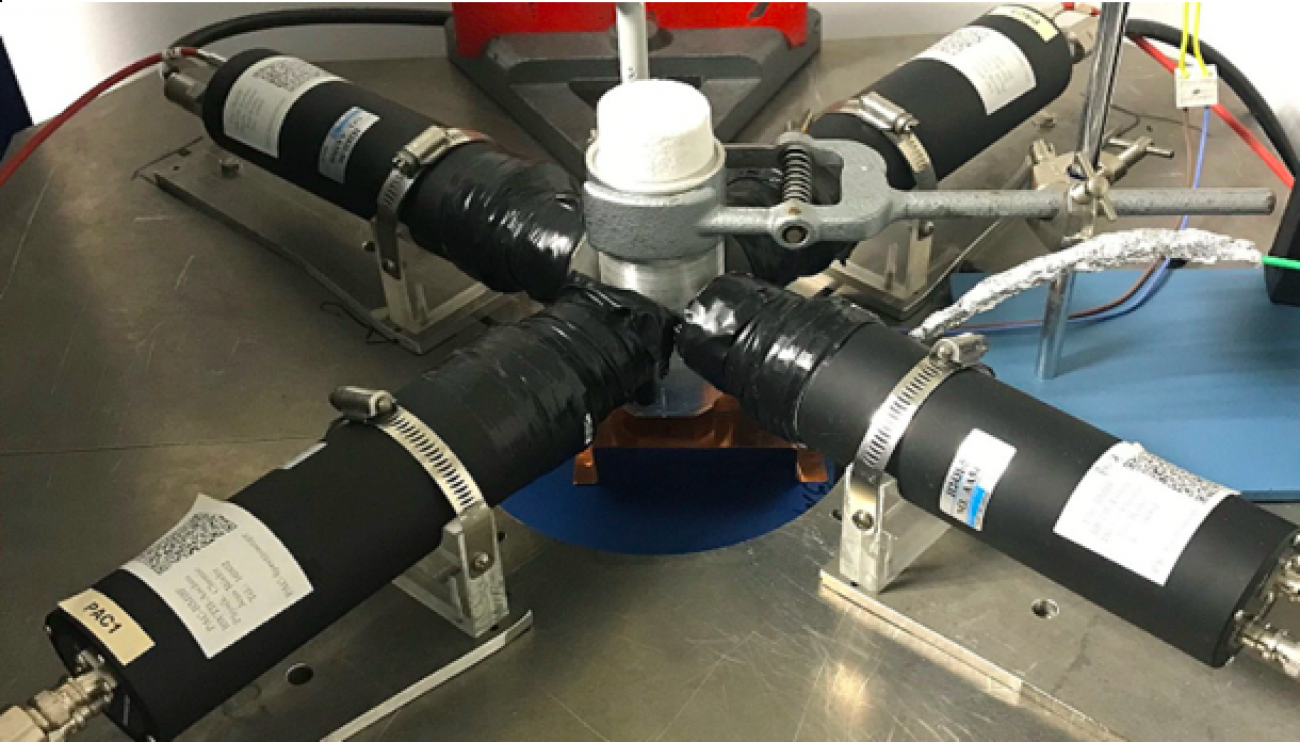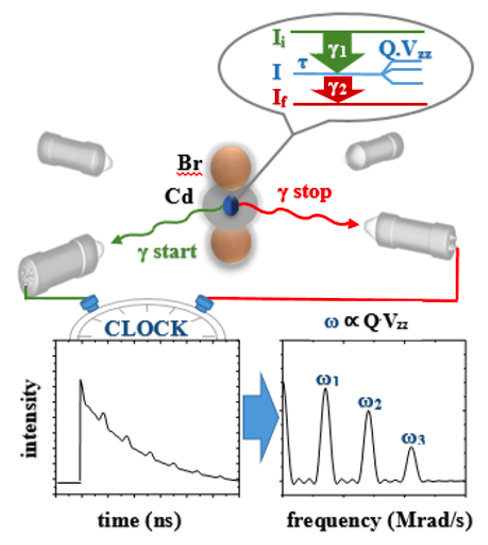ISOLDE determines precise nuclear moments by devising novel experimental technique

Nuclear quadrupole moments (Q), a measure of charge asymmetry in nuclei, are experimentally accessible via the quadrupole interaction frequency
Studies of short-lived nuclear excited states had up to now only been possible in solids, where theory is yet not sufficiently accurate. Using the pure isotope beams available at ISOLDE [1] and transforming them into molecules, the solid-state technique of g-g perturbed angular correlation (PAC) (Fig. 1 shows the table-top set-up), has now been used for the first time in project IS640 to measure

Fig.2: Schematic explanation of PAC measurement on a free molecule. The Cd nucleus (dark blue) with quadrupole moment Q interacts with the electric-field gradient of the electrostatic potential at the nucleus
The basic idea of the new approach is the fact that in a linear molecule the principal axis of the EFG is by symmetry along the molecular axis and the rotational angular momentum J is perpendicular to this for all states. The component of the EFG tensor along J is thus equal to -1/2 times that along the molecular axis. The nuclear spin I being much smaller than J for practically all thermally populated rotational states leads to a total
The resulting perturbation function is then expected to be very similar for all J states, highly resembling the well-known one for a randomly oriented axially symmetric EFG. The measured time patterns for the cases of HgCl2 and HgI2 (Fig 2) demonstrate these facts clearly: As expected, the period for the free molecule is approximately half the one for the molecular solid, and the addition of gas to the molecule sample destroys the periodic behavior due to collisions changing the axis of molecular rotation during the measuring time.

Fig. 3: Observed PAC patterns for Hg halides at room temperature (top), in the gas phase (middle), and with additional other gas (bottom) (blue: data, red: theory).
Since modern quantum chemistry techniques allow to calculate the EFG for small molecules with high accuracy, the nuclear quadrupole moment Q has been obtained from the measured
The achievement of the primary goal of the experiment is demonstrated in Fig.3. The values of Q for 111Cd(5/2+) determined from the data for three molecules (CdCl2, CdBr2, CdI2) essentially coincide, and considerably higher accuracy than available hitherto has been achieved. Accurate nuclear quadrupole moment values are essential benchmarks for nuclear structure models. There are obviously further elements where the developed techniques will be used to obtain precise values for Q, the closed-shell nuclei Pb and Sn being the most important ones from the nuclear physics standpoint.

Fig. 4: Resulting Q for 111Cd(5/2+) from recent EFG calculations using various methods; a: Ref. [4], b: Ref. [5], c: Ref. [6], d: Ref. [7], e: Present work
In addition, the fact that now precise values for the EFG can be quoted for the numerous solids previously investigated by PAC and other solid-state methods is of great relevance. One might hope that the presently not very accurate solid-state theory calculations can be improved by comparison with reliable experimental data.
The fact that in some cases precise
The newly developed experimental techniques will in future experiments also permit a quantitative way to investigate the molecular rotation axis change by gas collisions. Only for a few light molecules have such results to date become available from conventional NMR experiments. They form a critical test for the theoretical treatment of very-long-range interaction between atoms and molecules. First data for the collisions of HgI2 with noble gas atoms have already been obtained and are in the process of quantitative analysis.
References
[1] R. Catherall et al., The ISOLDE facility. J. Phys. G 44, 094002 (2017)
[2] H. Haas et al., Free molecule studies by perturbed g-g angular correlation: A new path to accurate nuclear quadrupole moments. Phys. Rev. Letters 125, 253001 (2021)
[3] H. Frauenfelder and R. M. Steffen, Angular correlations. In: Alpha-, beta- and gamma-ray spectroscopy, K. Siegbahn, Ed., pp 997-1198, NORTH HOLLAND, Amsterdam (1965)
[4] H. Haas and J. G. Correia, The quadrupole moments of Cd and Zn isotopes – an update. Hyperfine Interactions 198, 133 (2010)
[5] L. Errico et al., Precision of Electric-Field Gradient Predictions by Density Functional Theory and Implications for the Nuclear Quadrupole Moment and Its Error Bar of the 111Cd 245 keV 5/2+ Level. J. Phys. Chem. C 120, 23111 (2016)
[6] H. Haas, M. B. Barbosa and J. G. Correia, The quadrupole moments of Cd and Zn isotopes – an apology. Hyperfine Interactions 237, 115 (2016)
[7] H. Haas et al., Quadrupole moments of Cd and Zn nuclei: When solid-state, molecular, atomic, and nuclear theory meet. Euro. Phys. Lett. 117, 62001 (2017)
